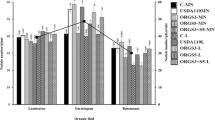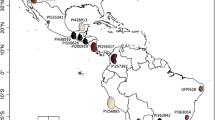Abstract
Promiscuous soybean lines have been bred on the basis that they would nodulate freely without artificial inoculation. However, our recent studies have demonstrated that the indigenous rhizobia are not able to meet their full nitrogen (N) requirement. Rhizobia inoculation might be necessary. We examined the competition for nodule formation among native Rhizobia spp. and two inoculated Bradyrhizobia strains (R25B indigenous strain and a mixture of R25B+IRj 2180A indigenous strain from soybean lines in the savanna of northern Nigeria), their effect on N fixation, and their contribution to the yield of four soybean cultivars, grown in the field in three different agroecological zones in the moist savanna of Nigeria. About 34% of nodules were formed by the mixture of introduced R25B+IRj 2180A, while R25B formed only about 24% of the nodules but did not influence biomass and grain yield production. The indigenous rhizobia strains that nodulated the soybean varieties fixed up to 70% of their accumulated total N, confirming the promiscuous nature of these soybean varieties. Even though these varieties fixed about 75 kg N ha−1; this was not enough to sustain their optimum grain yield, as earlier reported. However, the grain yield from inoculated soybean was not significantly higher than that from the uninoculated soybean, showing a degree of competitiveness among the introduced rhizobial strains and the native rhizobia population.
Similar content being viewed by others
References
Abaidoo RC (1997) Genetic diversity within Bradyrhizobia populations that nodulate soybean genotypes in Africa. PhD thesis, The University of Hawaii
George T, Singleton PW (1992) Nitrogen assimilation traits and dinitrogen fixation traits in soybean and common bean. Agron J 84:1020–1028
Harold HK, Fudi LI (1992) Potential for increasing biological nitrogen fixation in soybean. Plant Soil 141:119–135
Mpepereki S, Javaheri F, Davis P, Giller KE (2000) Soybeans and sustainable agriculture: promiscuous soybean in southern Africa. Field Crops Res 65:137–149
Nambiar PTC, Anjaiah V (1985) Enumeration of rhizobia by enzyme-linked immunosorbent assay. J Appl Bacteriol 58:187–193
Nantakorn B, Weaver RW (1982) Survival of cowpea rhizobia as affected by soil temperature and moisture. In: Graham PH, Harris SC (eds) Biological nitrogen fixation technology for tropical agriculture: papers presented at a workshop held at CIAT, 9–13, March 1981. CIAT, Cali, Colombia
Osa-Afiana LO, Alexander M (1979) Effect of moisture on the survival of Rhizobium in soil. Soil Sci Soc Am J 43:925–930
Peoples MB, Faizah AW, Rerkasem B, Herridge DF (1989) Methods for evaluating nitrogen fixation by nodulated legumes in the field. Australian Centre for International Agricultural Research, Canberra
Pulver EL, Brockman F, Wein C (1982) Nodulation of soyabeans cultivars with Rhizobium spp. and their response to inoculation with R. japonicum. Crop Sci 22:1065–1070
Rao VR, Ayanaba A, Eaglesham AJ, Kueneman EA (1981) Exploiting symbiotic nitrogen fixation for increasing yields in Africa. In: Emejuaiwe SO, Ogunjobi O, Sanni SO (eds) GIAM VI: global impacts of applied microbiology. Academic Press, London, pp 153–167
RENEASA (Rhizobium Ecology Network of East and Southern Africa) (1996) Legume inoculation response and farmer perceptions of nitrogen fixation and legume inoculants. Technical report on Phase II activities
Sanginga N, Abaidoo R, Dashiell K, Carsky R, Okogun A (1996) Persistence and effectiveness of rhizobia nodulating promiscuous soybeans in moist savanna zones of Nigeria. Appl Soil Ecol 3:215–224
Sanginga N, Dashiell K, Okogun JA, Thottappilly G (1997) Nitrogen fixation and N contribution by promiscuous nodulating soybeans in the southern Guinea savanna of Nigeria. Plant Soil 195:257–266
Sanginga N, Thottappilly G, Dashiell K (2000) Effectiveness of rhizobia nodulating recent promiscuous soyabean selections in the moist savanna of Nigeria. Soil Biol Biochem 32:127–133
SAS (Statistical Analysis System) (1989) SAS/STAT user's guide, 4th edn, vol 1. SAS Institute, Cary, N.C.
Somasegaran P, Hoben HJ (1994) Handbook for Rhizobia: methods in legume-rhizobium technology. Springer, Berlin Heidelberg New York
Vidor C (1982) Microbial constraints to legume symbiosis. In: Graham PH, Harris SC (eds) Biological nitrogen fixation technology for tropical agriculture: papers presented at a workshop held at CIAT, 9–13, March 1981. CIAT, Cali, Colombia
Vincent JM (1970) A manual for the practical study of root-nodule bacteria. (IBP handbook no 15) Blackwell, Oxford
Weaver RW, Frederick LR (1972) A new technique for most probable number of rhizobia . Plant Soil 36:219–222
Acknowledgements
The authors are grateful to Messrs V.O. Adedokun, I.O. Ajeigbe, M.O. Eniola, S. Oyelowo and W. Oyekanmi of the Soil Microbiology Laboratory of IITA for their technical assistance.
Author information
Authors and Affiliations
Corresponding author
Rights and permissions
About this article
Cite this article
Okogun, J.A., Sanginga, N. Can introduced and indigenous rhizobial strains compete for nodule formation by promiscuous soybean in the moist savanna agroecological zone of Nigeria?. Biol Fertil Soils 38, 26–31 (2003). https://doi.org/10.1007/s00374-003-0611-8
Received:
Accepted:
Published:
Issue Date:
DOI: https://doi.org/10.1007/s00374-003-0611-8




